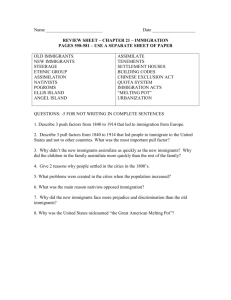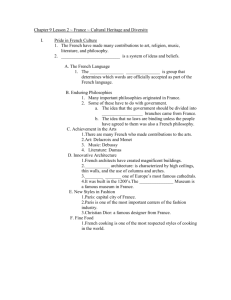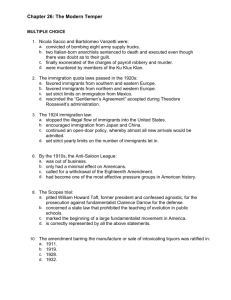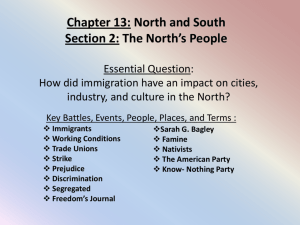Chapter 18 Video Guide
advertisement
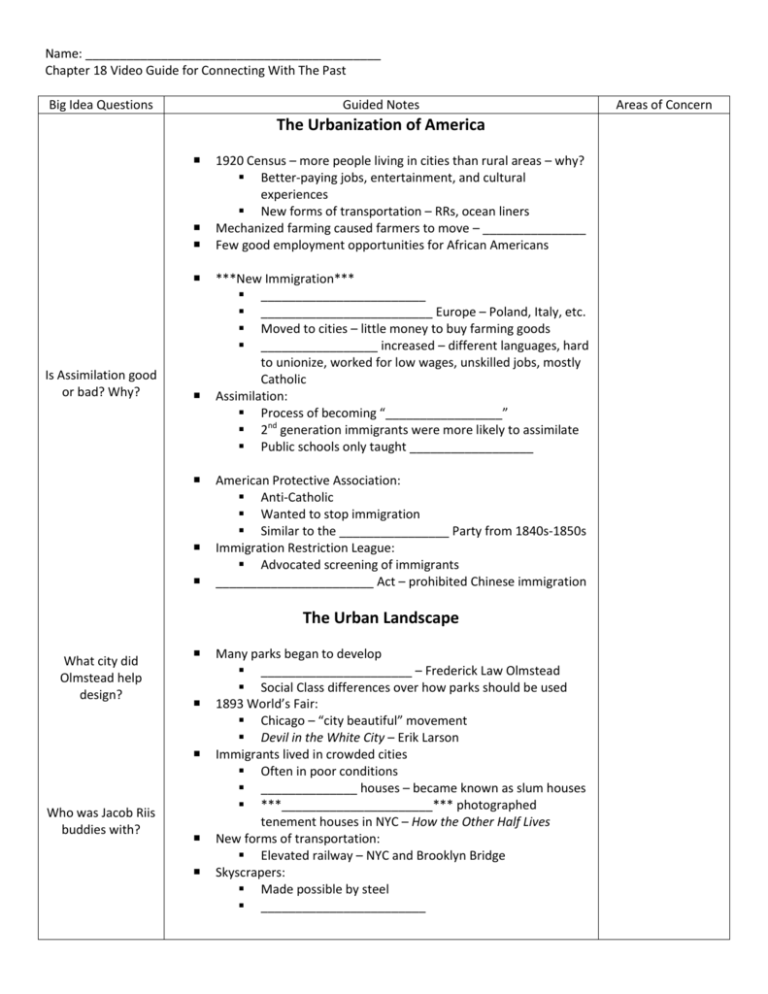
Name: ___________________________________________ Chapter 18 Video Guide for Connecting With The Past Big Idea Questions Guided Notes The Urbanization of America Is Assimilation good or bad? Why? 1920 Census – more people living in cities than rural areas – why? Better-paying jobs, entertainment, and cultural experiences New forms of transportation – RRs, ocean liners Mechanized farming caused farmers to move – _______________ Few good employment opportunities for African Americans ***New Immigration*** ________________________ _________________________ Europe – Poland, Italy, etc. Moved to cities – little money to buy farming goods _________________ increased – different languages, hard to unionize, worked for low wages, unskilled jobs, mostly Catholic Assimilation: Process of becoming “_________________” 2nd generation immigrants were more likely to assimilate Public schools only taught __________________ American Protective Association: Anti-Catholic Wanted to stop immigration Similar to the ________________ Party from 1840s-1850s Immigration Restriction League: Advocated screening of immigrants _______________________ Act – prohibited Chinese immigration The Urban Landscape What city did Olmstead help design? Who was Jacob Riis buddies with? Many parks began to develop ______________________ – Frederick Law Olmstead Social Class differences over how parks should be used 1893 World’s Fair: Chicago – “city beautiful” movement Devil in the White City – Erik Larson Immigrants lived in crowded cities Often in poor conditions ______________ houses – became known as slum houses ***______________________*** photographed tenement houses in NYC – How the Other Half Lives New forms of transportation: Elevated railway – NYC and Brooklyn Bridge Skyscrapers: Made possible by steel ________________________ Areas of Concern Strains of Urban Life Who coined “Honest Graft?” Disasters in cities: Chicago and Boston (1871) _________________ San Francisco (1906) earthquake -> fire Disease in cities: _______________________ drinking water Growing number of city residents were poor _______________________ (1879 Political Machines: (___________________ Hall) Provided jobs and assistance to constituents Honest Graft: Inside scoop on government projects Buy land before government, then ___________________ _________________________________ Dishonest Graft: Stealing William “Boss” Tweed Stole roughly ________________________ through fraud Controlled elections Ultimately captured due to __________________ political cartoons The Rise of Mass Consumption Many jobs saw a rise in wages Women, African Americans, and Mexicans were largely __________________________ ▪ Textiles, paper, laundries, etc. Key inventions that affected industry: Sewing Machine -> out of homes, into factories and stores Refrigerated railcar -> __________________ industry Changes in shopping Chain and department stores: ▪ Woolworth’s – dry goods ▪ Montgomery Ward and Sears Roebuck _________________ – helped farmers ▪ Macy’s Department Store Impact of these new ways of buying goods? ▪ Small businesses were affected ▪ Women advocated ______________________ and improvement in wages and working conditions Leisure in the Consumer Economy Did you know what the first baseball team was? “8 hours for work, 8 hours for rest, 8 house for what we will” Amusement parks – Coney Island Sports: Baseball ▪ ______________________ __________!!!! (1869) ▪ 1919 World Series Scandal – THE REDS WIN! Horse racing – Kentucky Derby What was The Birth of a Nation about? How did yellow journalism get its name? College Football – NCAA Movies: Silent films until the 1920s D.W. Griffith – __________________________________ The Saloon: Meeting place for working-class individuals Important gathering place for political machines Growth of __________________________________: Response to the saloon and immigrants Anti-Saloon League: ▪ Hoped to cut down on crime and political machines Growth of Newspapers: “Yellow Journalism” – ___________________ news stories ▪ William Randolph Hearst - Journal ▪ Joseph Pulitzer - World High Culture in the Age of the City Have you read The Jungle? Would you want to? Fictitious bonus points: Who was the “father of education” from the 1800s? Man you should know him…… Important Writings: Frank Norris – The ____________________ ▪ Depicted relationship between farmers and railroads _____________________________ – The Jungle ▪ Exposed horrors of meat packing industry ▪ Pure Food and Drug Act, Meat Inspection Act (1906) Ashcan School: Artwork that depicted slums and “grim aspects of modern life” Theory of Evolution (Darwin) challenged religion and schools Scopes Trial in the 1920s “___________________________” Ideas were to be tested, not just based on theories Education John Dewey: ▪ Hoped to change _____________________ ▪ Less reliance on memorization, more on acquiring knowledge through experience Growth of Education: ▪ Increase in free primary and secondary education ▪ ___________ areas still lagged behind __________________________________ Grant ▪ Land set aside to states by federal government for colleges Higher education opportunities for women were limited ▪ Some institutions created separate female schools




